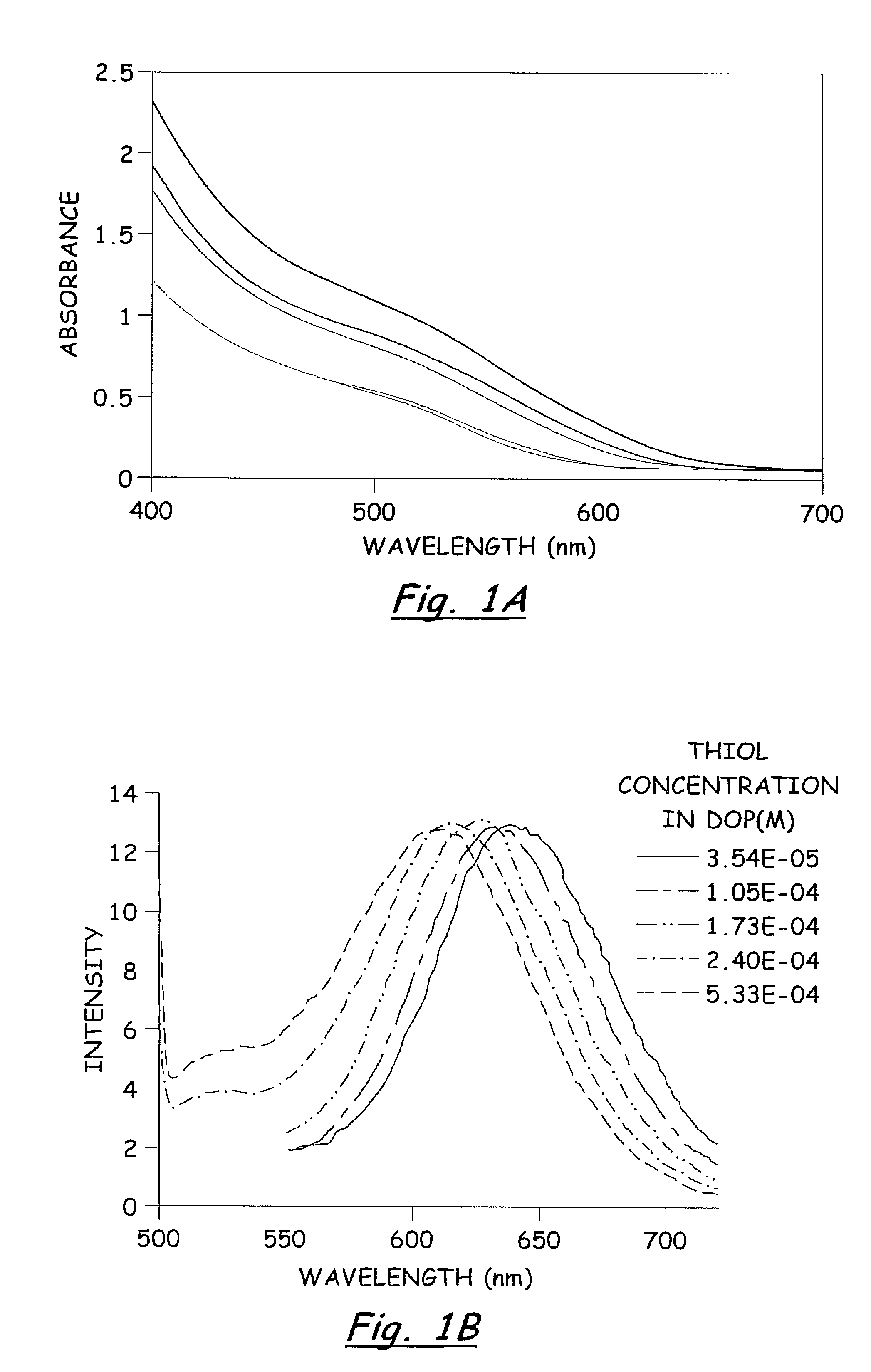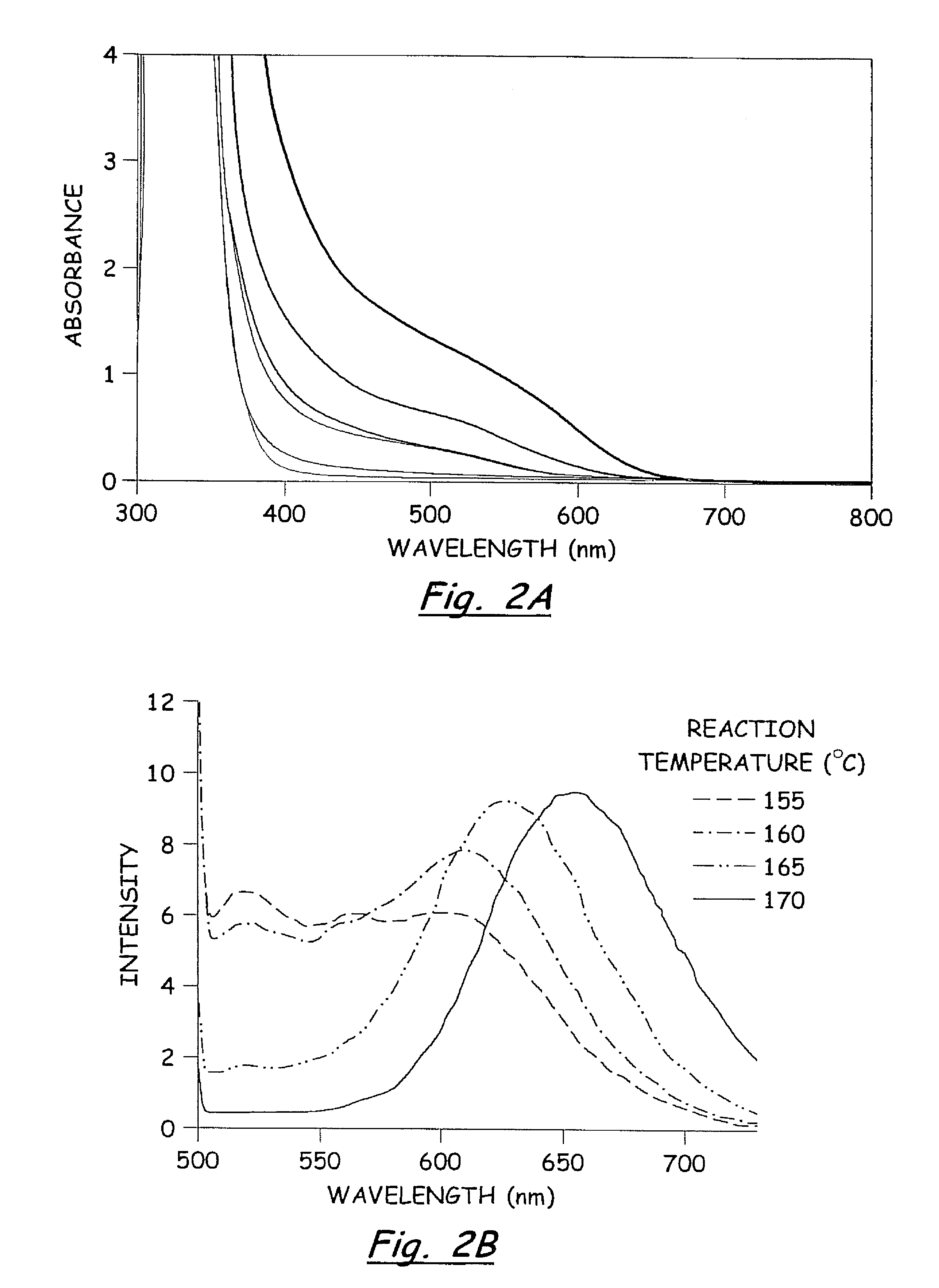Rapid synthesis and size control of chalcopyrite-based semi-conductor nanoparticles using microwave irradiation
a technology of semi-conductor nanoparticles and microwave irradiation, which is applied in the field of nanoparticles of chalcopyrite, can solve the problems of non-uniform nucleation and particle growth, and achieve the effects of dramatic decrease in reaction times, increased microscopic temperature of reaction, and greater homogeneity in the overall reaction temperatur
- Summary
- Abstract
- Description
- Claims
- Application Information
AI Technical Summary
Benefits of technology
Problems solved by technology
Method used
Image
Examples
example 1
Preparation of [P(i-But)3]2CuIn(SEt)4 Single Source Precursor (SSP 1)
Inert atmosphere techniques and anhydrous conditions were applied to the 5preparation of SSPs. All glassware was either flame dried or oven dried and flushed with nitrogen before use. The reactions and the purification processes were performed under a dry nitrogen atmosphere.
In a flame dried 500 ml three neck flask, 60 ml of anhydrous methanol was added followed by 30 wt % NaOMe (1.85 ml, 9.68 mmol) in MeOH and EtSH (0.75 ml, 9.68 mmol) resulting in a reddish solution. InCl3 (532 mg. 2.42 mmol) was added to the reaction mixture and the solution was stirred for 15 min A solution of CuCl (237 mg, 2.42 mmol) and P(i-But)3 (1.22 ml, 4.84 mmol) was prepared in CH3CN and added to the reaction resulting in a pale green solution. The reaction mixture was further stirred for up to 24 h.
Upon completion, solvent was removed in vacuo and dry hexane was added under N2 to precipitate NaCl salt. Under N2, the mixture was filtered...
example 2
Preparation of (PPh3)2 CuIn(SEt)4 Single Source Precursor (SSP 2)
In a flame dried 500 ml three neck flask, 60 ml of anhydrous methanol was added followed by 4.5 ml (23 mmol) of 30 wt % NaOMe in MeOH and 2.2 ml (29 mmol) EtSH resulting in a reddish solution. InCl3 1.3 g (5.8 mmol) was added to the reaction mixture and the solution was stirred for 15 min. A solution of CuCl 0.57 g (5.8 mmol), and PPh3 3.1 ml, (16 mmol) in 60 ml of CH3CN was added to the reaction mixture resulting in a pale green solution. The reaction mixture was further stirred for up to 24 h.
Upon completion, solvent was removed in vacuo and anhydrous benzene was added under N2 to precipitate NaCl salt. The solution was collected by syringe and the solvent was removed under vacuum. A light yellow solid was obtained (4.45 g, 89%). The resulting solid was used without further purification for the preparation of CuInS2 nanoparticles. P31 NMR CDCl3 δ: −155; H1 NMR CDCl3 δ: 1.12 (12H, t, J=6.6 Hz), 2.56 (8H, q, J=6.9, 13....
example 3
Microwave-Assisted Synthesis of CuInS2 Nanoparticles from SSP 1
In a dry Milestone microwave vessel, 1 ml of 0.033 M solution of SSP 1 in DOP was added followed by addition of varying amounts of hexanethiol (0.01-0.30 ml) (Hexanethiol acts as a surface pacifying ligand, has a relatively high boiling point, and provides excellent solubility in common organic solvents). An additional 20 ml of DOP was added to the microwave vessel and the solution was capped and stirred for 5 min at room temperature to insure a homogeneous solution. The reaction vessel was placed in the Milestone Microwave Labstation and allowed to ramp to 140-170° C. over 10 min followed by isotherm for 10-20 min. Upon completion, the reaction was cooled to room temperature to provide a homogenous colored solution containing CuInS2 nanoparticles.
The resulting nanoparticles were isolated from the colloidal DOP solution by treating each 1 ml of DOP solution with 30 ml of MeOH and chilling to −15° C. for 12-24 h. The resu...
PUM
| Property | Measurement | Unit |
|---|---|---|
| quantum size | aaaaa | aaaaa |
| size | aaaaa | aaaaa |
| size | aaaaa | aaaaa |
Abstract
Description
Claims
Application Information
 Login to View More
Login to View More - R&D
- Intellectual Property
- Life Sciences
- Materials
- Tech Scout
- Unparalleled Data Quality
- Higher Quality Content
- 60% Fewer Hallucinations
Browse by: Latest US Patents, China's latest patents, Technical Efficacy Thesaurus, Application Domain, Technology Topic, Popular Technical Reports.
© 2025 PatSnap. All rights reserved.Legal|Privacy policy|Modern Slavery Act Transparency Statement|Sitemap|About US| Contact US: help@patsnap.com



